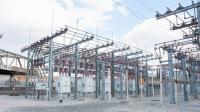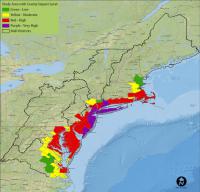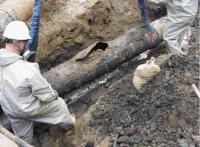-
Using device “fingerprints” to protect power grid, industrial systems

Human voices are individually recognizable because they are generated by the unique components of each person’s voice box, pharynx, esophagus and other physical structures. Researchers are using the same principle to identify devices on electrical grid control networks, using their unique electronic “voices” — fingerprints produced by the devices’ individual physical characteristics — to determine which signals are legitimate and which signals might be from attackers. A similar approach could also be used to protect networked industrial control systems in oil and gas refineries, manufacturing facilities, wastewater treatment plants and other critical industrial systems.
-
-
Calculating monetary losses from floods caused by sea level rise
Damages from extreme events like floods are even more relevant than the mean sea level itself when it comes to the costs of climate impacts for coastal regions. However, while it is now rather well understood how sea-levels will rise in the future, only small progress has been made estimating how the implied damage for cities at the coasts will increase during the next decades. Scientists now provide a method to quantify monetary losses from coastal floods under sea-level rise. For the first time, the scientists show that the damage costs consistently increase at a higher rate than the sea-level rise itself.
-
-
WikiLeaks list not connected to terrorist attacks

The WikiLeaks organization was criticized for providing a target list for terrorists when it published a secret memo in 2010 with 200 international sites that the U.S. Department of Homeland Security considered critical to national security. Was there any truth to that claim?
-
-
Calif. gas well blowout caused U.S. largest methane release, study finds
The Aliso Canyon natural gas well blowout released more than 100,000 tons of the powerful greenhouse gas methane before the well was finally plugged 11 February, according to the first study of the event. The results confirm that it was the largest methane leak in U.S. history.
-
-
Sea-level rise in twentieth century faster than in any previous century
Global sea level rose faster in the twentieth century than in any of the twenty-seven previous centuries, according to a new study. Moreover, without global warming, global sea level would have risen by less than half the observed twentieth century increase and might even have fallen. Instead, global sea level rose by about 14 centimeters, or 5.5 inches, from 1900 to 2000. This is a substantial increase, especially for vulnerable, low-lying coastal areas.
-
-
New tool for coastal planners preparing for sea level rise

Scientists have developed a new model to help coastal planners assess the risks of sea level rise. Put to use on a global scale, it estimates that the oceans will rise at least twenty-eight centimeters on average by the end of this century — and as much as 131 cm if greenhouse gas emissions continue to grow unchecked.
-
-
Experts tackle U.K. flood risk
The U.K. Blue-Green Cities Research Project combines the expertise of academics from nine U.K. universities plus partners in the United States and China specializing in flood inundation modelling, computation fluid dynamics, sediment debris processes, river restoration and habitats, urban drainage infrastructure, environmental economics, uncertainty, flood risk management, and stakeholder engagement. The project’s goal is to make U.K. cities more resilient to flooding.
-
-
Protecting Earth by crashing spacecraft into asteroids
Asteroids headed for a collision with the Earth, if found early enough, can be acted upon to prevent the potentially devastating consequences of an impact. One technique to divert an asteroid, called kinetic impact, uses a spacecraft to crash into the body at high speeds.
-
-
Protecting the grid from weather geomagnetic storms
On 9 March 1989, a huge cloud of solar material exploded from the sun, twisting toward Earth. When this cloud of magnetized solar material — called a coronal mass ejection, or CME — reached our planet, it set off a chain of events in near-Earth space that ultimately knocked out power to the Canadian province Quebec for about nine hours. Though CMEs hit Earth often, those with the potential to shut down an entire power grid are rare — and scientists want to make sure that next time, we are prepared. Because space weather can have — at its very worst — such significant consequences, scientists from NASA are creating models to simulate how space weather can impact our power grid.
-
-
Russian govt. behind attack on Ukraine power grid: U.S. officials
Obama officials said that Russian hackers were behind a December 2015 cyberattack on Ukraine’s power grid. The attack caused power outages and blackouts in 103 cities and towns across Ukraine. Elizabeth Sherwood-Randall, deputy Energy Secretary, made the comments to a gathering of electric power grid industry executives.
-
-
Better Greenland, Antarctica sheet modeling helps predict sea-level rise
The Greenland and Antarctic ice sheets will make a dominant contribution to twenty-first century sea-level rise if current climate trends continue. However, predicting the expected loss of ice sheet mass is difficult due to the complexity of modeling ice sheet behavior. Better to understand this loss, a team of Sandia National Laboratories researchers has been improving the reliability and efficiency of computational models that describe ice sheet behavior and dynamics.
-
-
Helping to optimize grid
The nation’s electric power grid is becoming more complex. As the system incorporates more sources of renewable energy, such as solar and wind power, utilities need new ways to manage it more efficiently, and the U.S. Department of Energy’s (DOE’s) Argonne National Laboratory says it is responding to that need.
-
-
FBI launches investigation of lead poisoning of Flint’s drinking water

The FBI has launched an investigation into the contamination of drinking water in Flint, Michigan, which has left Flint children and other residents poisoned by lead. In a hearings on the Hill yesterday, lawmakers from both parties described what is happening in Flint as a “a man-made public health catastrophe.” Flint’s drinking water became contaminated with lead in April 2014 after a state-appointed emergency manager ordered city officials temporarily to switch the city’s water source from Lake Huron water treated by the Detroit Water and Sewerage Department to water from the Flint River, treated at the Flint water treatment plant. The order by the state-appointed emergency manager was part of the state’s cost-cutting measures.
-
-
In kids, even low lead levels can cause lasting harm
Until a few years ago, the federal standard for action was 10 micrograms per deciliter of blood, and in 2012 it was lowered by half in recognition of evidence showing a lower threshold of concern. But the truth is there is no known safe level of blood lead for children, and the American Academy of Pediatrics and the Centers for Disease Control and Prevention have said as much. The medical research community has documented negative impacts on children with even lower levels of lead exposure than the current 5 micrograms per deciliters standard. With that view, we might consider every child with a confirmed nonzero lead test as at-risk. Testing lead blood levels in children is simply too late. This is akin to the TSA searching for lethal weapons after the passengers have boarded the flight and the plan has taken off. Once the lead is in the bloodstream, the damage is real and lasting for these children, and the options for response are far fewer and less effective. Children living in low-income neighborhoods, children of color, and children whose families live in rental housing are statistically at the greatest risk of exposure to lead. That means the children most at risk of lead exposure also disproportionately face the effects of poverty, low-resource communities, and trauma.
-
-
Realistic data needed to develop the 21st century power grid

Say you have a great new theory or technology to improve the nation’s energy backbone — the electric grid. Would it not be great to test it against a model complete with details that would tell you how your ideas would work? But it is a challenge, because existing sets of data are too small or outdated; and you do not have access to real data from the grid because of security and privacy issues. To overcome this problem, is helping to create open-access power grid datasets for researchers and industry.
-
- All
- Regional
- Water
- Biometrics
- Borders/Immig
- Business
- Cybersecurity
- Detection
- Disasters
- Government
- Infrastructure
- International
- Public health
- Public Safety
- Communication interoperabillity
- Emergency services
- Emergency medical services
- Fire
- First response
- IEDs
- Law Enforcement
- Law Enforcement Technology
- Military technology
- Nonlethal weapons
- Nuclear weapons
- Personal protection equipment
- Police
- Notification /alert systems
- Situational awareness
- Weapons systems
- Sci-Tech
- Sector Reports
- Surveillance
- Transportation
Advertising & Marketing: advertise@newswirepubs.com
Editorial: editor@newswirepubs.com
General: info@newswirepubs.com
2010-2011 © News Wire Publications, LLC News Wire Publications, LLC
220 Old Country Road | Suite 200 | Mineola | New York | 11501
Permissions and Policies
Editorial: editor@newswirepubs.com
General: info@newswirepubs.com
2010-2011 © News Wire Publications, LLC News Wire Publications, LLC
220 Old Country Road | Suite 200 | Mineola | New York | 11501
Permissions and Policies
